Written by our rad team member and Leave No Trace Trainer, Amanda Winther
Illustrations by Mod Bird Creative
How to Plan a Leave No Trace Elopement
If you’re here (welcome, welcome!) chances are that you’ve got your eye on an outdoors elopement, and a Leave No Trace elopement may be the perfect way to marry your best friend while reducing your environmental footprint. I help couples plan elopements almost every single day (yes, I really think I have the best job ever!), and I use Leave No Trace and the Seven Principles as a lens to help me show respect for these gorgeous places where we’ll make your most cherished memories (and of course we’ll capture stunning images)!
When I first started learning about Leave No Trace, there was definitely a bit of a steep learning curve! I want to try and help make learning about these principles and treating outdoor places with the most respect we can as easy as possible. That’s why I am so excited to share this full guide to planning your Leave No Trace elopement. In this guide, I’m breaking down what is Leave No Trace, what are the Seven Principles, why knowing about these principles is important for anyone who wants to have an adventure or outdoor elopement, and how can you apply each principle to your elopement. One thing I’ll point out here is that Leave No Trace isn’t something you learn in one day, but you learn more every time you go outside. I’m still learning myself! In fact, Amanda, our amazing copy writer here at Between the Pine, who happens to be a Leave No Trace Trainer (yes I know- she really is that cool!) helped me craft this blog post to help you better understand how you can plan a LNT elopement! So grab your notebook, a snack or two (duh! lol) and get ready to learn *all* about this ethical framework. You know I’m going to share some fun facts! (Yes please!)

What is Leave No Trace?
Maybe you’ve heard the term before, but what exactly is Leave No Trace? Don’t you worry- I am going to explain it all to you! Ready for me to nerd out?! Leave No Trace started as a collaboration between three public lands agencies, the National Park Service (NPS), US Forest Service (USFS), and Bureau of Land Management (BLM) and the National Outdoor Leadership School (NOLS) in 1987. In 1994, the Leave No Trace Center for Environmental Ethics, a 501c3 (aka non-profit) was officially created to promote environmental responsibility and stewardship through interactive, science-based (heck yes!) education. Many of the signs you see at your local parks and National Parks are probably created in partnership with the Leave No Trace Center and informed by the Leave No Trace Seven Principles (spoiler: you won’t have to wait long to learn what these are all about).
As the full name (Leave No Trace Center for Environmental Ethics) says, Leave No Trace is an ethic or ethical framework. That means rather than being hard and fast rules, Leave No Trace and the Seven Principles is really a framework to help you make decisions that respect the environment, ecosystems, waterways, wildlife, and other visitors outdoors. A lens to help us learn ways to leave less impact! And it’s backed by science! You know I’m gonna be a huge fan!
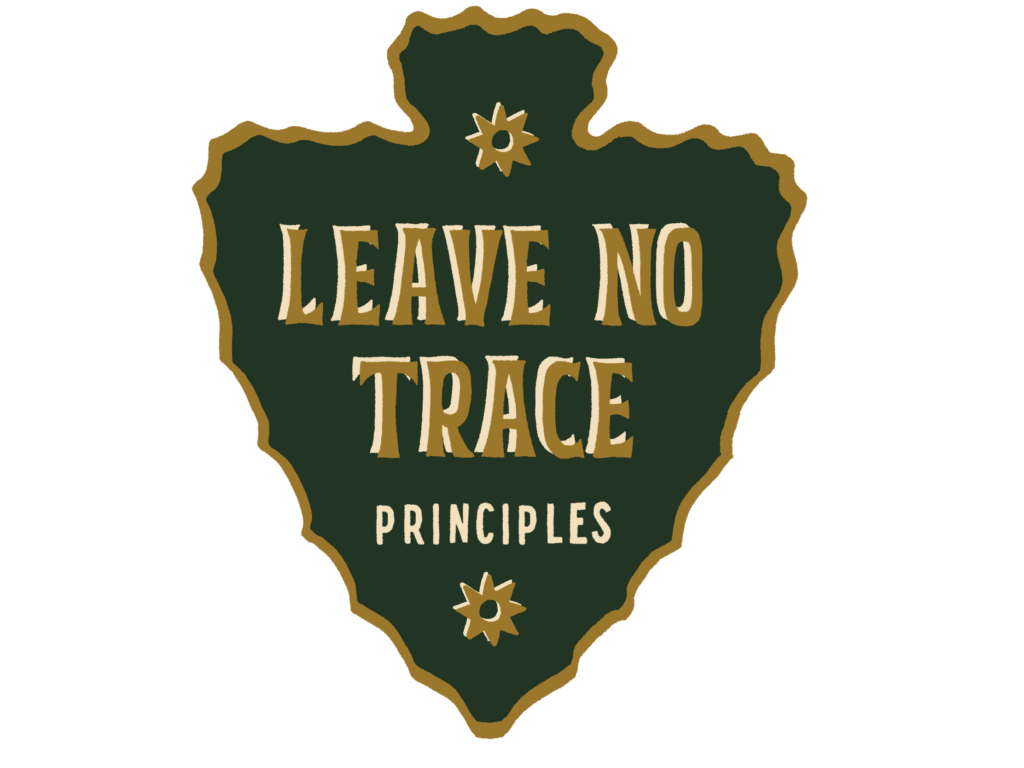
What are the Leave No Trace Seven Principles?
The Leave No Trace Seven Principles is the core of the Leave No Trace curriculum. These principles were first used to help people minimize their impact in the backcountry (aka remote areas), but they can really be applied to any situation outdoors. Okay, I know you just can’t wait to hear about them (and I can’t wait to share them with you!), so here are the Seven Principles of Leave No Trace:
- Plan ahead and prepare
- Travel and camp on durable surfaces
- Dispose of waste properly
- Leave what you find
- Minimize campfire impacts
- Respect wildlife
- Be considerate of other visitors
(© 1999 by the Leave No Trace Center for Outdoor Ethics: www.LNT.org)
Now you know what the Seven Principles are. So, pull up a chair, grab your fav drink (maybe a marg or oat milk latte??), and let’s learn more about what exactly they mean and how you can use them to plan your Leave No Trace elopement.
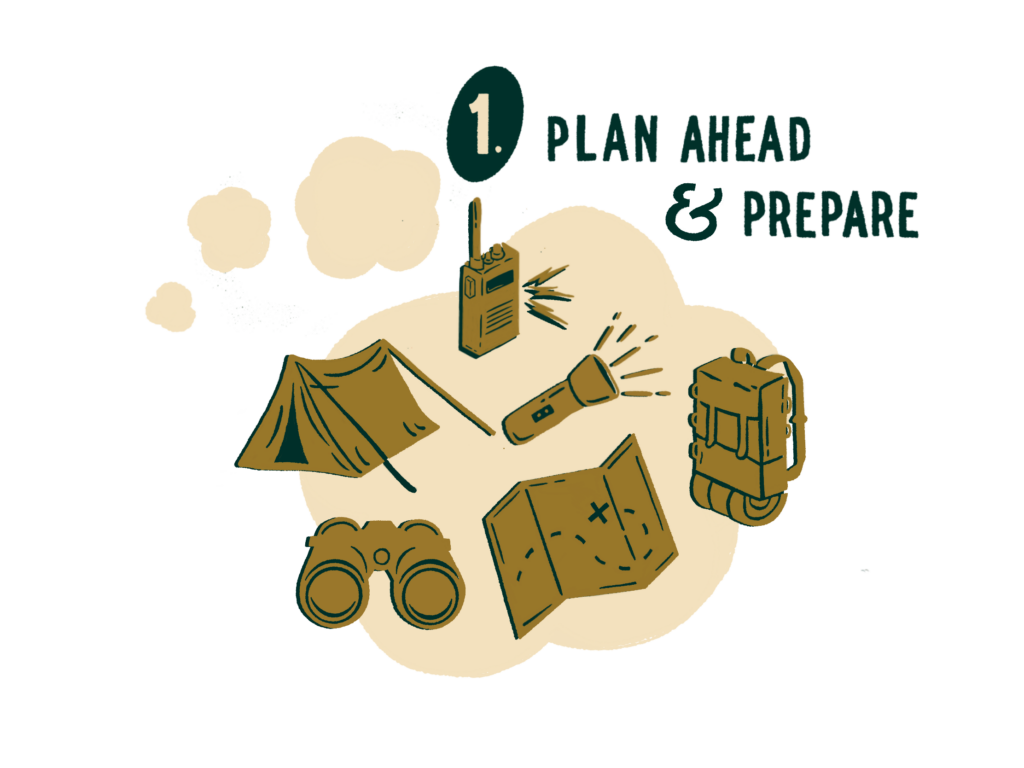
Principle #1: Plan ahead and prepare – a checklist for your Leave No Trace elopement
One of my greatest loves (in addition to my partner Drew, who was also my high school sweetheart, swooooon!) is helping couples plan their dream elopement in some of the most beautiful places in the world. So I’m *super* into the first Leave No Trace principle: plan ahead and prepare. Actually, I created pretty much all of the content on Between the Pine to help you make the most of your big day by figuring out where to go, and knowing what to expect when you get there. So, yes, planning is my jam. And Leave No Trace is my peanut butter. Or toast. Or butter.. Ok you get the point. Here is my checklist for planning your Leave No Trace elopement:
- Learn about Leave No Trace & The Seven Principles (check! You’re reading this right now-feel free to bookmark it too!)
- Choose your dream location (aka visit the relevant guides on this blog!)
- Pick your date & hire your elopement photographer and vendors
- Get your marriage license & wedding permit (if needed)
- Look up the National Park or public land regulations
- Check weather, trail conditions & download a trail map
- Pack for your elopement!
The first thing you’ll want to do when planning your Leave No Trace elopement, is learn about Leave No Trace. Well, you’re in a great place to do that! Keep reading this full guide (and bookmark it to come back to again and again).
Next, you’ll want to choose your dream location and elopement date. If you need help with that you know where to find my corner of the internet (oh hi, it’s right here!) where I’ve put together tons of resources to help you narrow down the perfect location, from the Pacific Northwest to Hawaii and beyond. Not only do I know a photographer who would be stoked to adventure with you for your elopement (cough, cough), I also know planners, caterers, makeup artists, florists, and officiants who are ready to adventure, too! For all couples I work with, I send over a list of vendors who you can be sure to trust with your adventurous wedding day.
Some locations require a photography permit for your elopement. But, not to worry, for all my couples, this is something I take care of! Let’s talk about a marriage license! Every state is different in regard to the number of witnesses, how to apply, and how long the license is valid for. These details are things we will talk through as we plan your elopement and, if you need a witness, I would be more than honored to sign that dotted line!
Next up, we’ll double check the relevant park regulations, camping regulations (if you’ll be camping) and trail closures. This is an extremely important step as far as keeping your elopement Leave No Trace. Every public land or park is unique. Some parks have designated dog-friendly trails, and others don’t allow dogs on any of the trails, some parks have regulations around maximum group size, some parks close at night. Park regulations also change throughout the year, and certain locations, trails, or roads can close due to things like weather (aka high passes may close in the winter), or to protect endangered animals (for example, some areas in North Cascades National Park close for peregrine falcon nesting season). Most parks and public lands also outline fire regulations on their National Park or public land website. When in doubt about regulations, you can usually reach a Ranger on the phone pretty easily (bonus: they’re super friendly!)
Finally, you’ll want to pack for your elopement! Are you as excited as I am?! Depending on where and when you’re eloping, I recommend packing slightly different things, but you’ll pretty much always want water (in your reusable bottle– I always have MiiR with me!), comfy shoes for walking or hiking, sunscreen, layers, and snacks (did someone say snacks!?).

Need help figuring out what to pack for your elopement? Check out these resources:
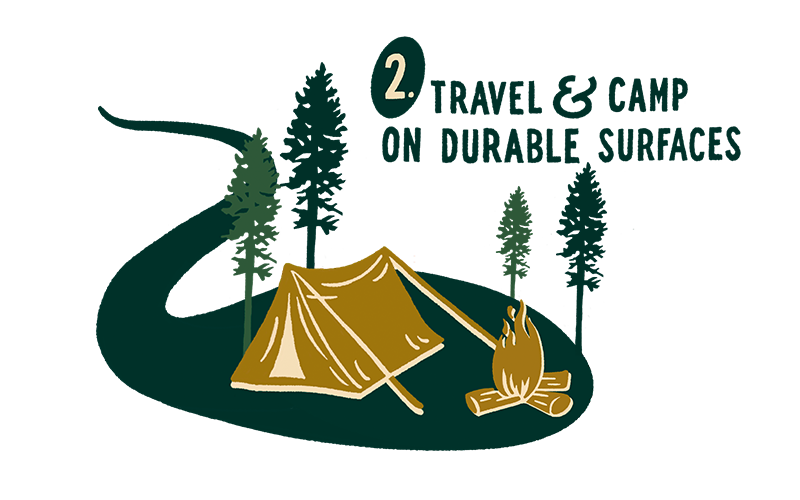
Principle #2: Travel and camp on durable surfaces: how to choose your Leave No Trace elopement location
Travel and camp on durable surfaces is the second principle of Leave No Trace, and it’s a great way to decide on your elopement location! Here are a few steps to follow when choosing the best location for your Leave No Trace elopement:
- Learn what durable surfaces are
- Learn about some (really cool!) non-durable surfaces to avoid
- Bring comfy & supportive hiking shoes or boots
So what exactly is a durable surface? According to Leave No Trace, “durability refers to the ability of surfaces or vegetation to withstand wear or remain in a stable condition.” If you think about it, pretty much any step we take will leave some impact on the environment. So, this principle is all about trying to leave the lightest footprints. Trampling damages vegetation and causes soil erosion in pretty much every environment, so what you’re looking for here is a surface that you won’t trample. I always try to put on my “is this a durable surface? does it trample?” hat when deciding where to put my feet (or tent!).
Staying on the established trail is the absolute best way to minimize your impact. FYI: an established trail is usually about two humans wide (sometimes more, sometimes less) and dirt, gravel, or wood. It’s not always possible to stay on the main trail, so here are some other examples of surfaces where your footprints will leave less of an impact: rock, packed dirt, gravel, water, deep snow and ice (assuming there is enough of a base to protect any sensitive vegetation underneath!), and dry grasses, which tend to have a hearty root structure and flexible stems. If a trail is muddy, it’s better to walk through the mud than create a new side trail (and that’s why you’ll always find me rocking my fav hiking boots!) Staying on the main trail also means you’ll want to avoid shortcuts, especially on switchbacks (which is what we call the trail when it zig zags up a steeper section) and social trails (or trail offshoots that others have created).
Now you know what a durable surface is. But what is a non-durable surface? (aka what are some surfaces that are highly susceptible to trampling or our footprints?) Wet grass, meadows and fields of wildflowers. There are also a few environments that deserve extra special attention when you go outside, particularly high alpine (above treeline) and high desert environments. It’s a wonder that anything can survive in these harsh places, but if you look closely, you’ll find little things growing everywhere, even in the alpine tundra!
An extra-special non-durable surface: cryptobiotic crusts and sensitive alpine tundra
High deserts are also home to one my copywriter Amanda’s favorite things to nerd out about: cryptobiotic soil. I’m still a bit newer to learning about this but she’s already taught me so much about these tiny organisms, and I’m so excited to pass along this info!
Okay, so soil might not sound super exciting at first, but bear with me. (Hmm.. where’s my soap box?!) Cryptobiotic soil, crusts, or “desert glue” is a special type of soil crust in high deserts in the Southwest and California. This special crust is filled with tons of tiny, microscopic blue-green algae (aka cyanobacteria) organisms, and often also lichen, mosses, and other microfungi. Crypto helps hold the soil in place. Without these invisible organisms, wind and water would easily erode the soil. The bacteria also provides essential micronutrients (like nitrogen and other organic matter) so that plants can grow in the world’s harshest places. Plus, they have a cool name! “Cryptobiotic” always makes me think of some wild sci-fi organism. And that’s kind of what they are! While these crusts provide so much for the environment, our human feet (and our pet’s paws!) can crush right through them. A crushed crust can take many years to grow back — at best five to seven years, and at worst, hundreds or thousands of years!
The main takeaway here is that you should stick to established trails and campsites especially in harsh environments like the deserts in and around Moab or Joshua Tree, tundra in the Rocky Mountains, or alpine meadows near Rainier. If you absolutely must walk through an area with crusts or tundra (though I can’t imagine why you should need to for your elopement since there are so many areas that are truly wild, incredible and still accessible!), you’ll want to walk single file in each other’s footprints to destroy as little as possible.
Oh, and here are two sweet little sayings you can keep in mind (and pass along!) when it comes to crypto:
- Don’t bust the crust!
- Do the crypto tiptoe!
(Not done nerding out yet!? I get it! Check out this article on the Joshua Tree National Park site for even more cool science about these tiny environmental protectors. And feel free to send other cool facts you find my way!)

Principle #3: Dispose of waste properly: Mollie’s top 6 tips to manage waste during your elopement
The third principle of Leave No Trace is dispose of waste properly. This guideline talks about all waste, including both physical waste (garbage), and human waste (aka #1 and #2). Here are six tips you can follow to help you follow this Leave No Trace principle during your elopement:
- Avoid bringing packaging with you (when possible)
- Carry a trash bag with you
- Don’t throw things: that includes bouquets, rice and even biodegradable confetti
- Do a site sweep as you’re leaving
- Carry out your TP, or use a kula cloth!
- Use toilets at the trailheads (and know the regulations when it comes to #2)
I love using these six short words that you may have heard before: pack it in, pack it out. Whatever you bring with you on your elopement, you’ll want to bring out with you. So, first things first, avoid bringing packaging when possible. One less piece of packaging is one less thing to accidentally leave behind. This is one reason why I always bring snacks in my favorite reusable silicone bags by stasher. I know that leaving my packaging behind entirely means something won’t slip out of my hand and fly away in a gust of wind while I’m enjoying 360-views or photographing a gorgeous couple on a fire lookout.
Second, bring a trash bag. That way you have a place for the trash you’ll want to carry out with you, and maybe even room to pick up someone else’s accidentally left behind trash. Bonus points if you bring something reusable like this trash can liner by bagito. (also how cool would it be to get these embroidered or printed as a rad gift for elopement guests?!).
I’ve learned a lot more about this next tip over the years: don’t throw anything on the trail. This probably seems more obvious for non-biodegradable things like plastic bags or aluminum cans, which believe it or not take between 10-20 years (for plastic), and 80-100 years (for aluminum) to decompose (what?!). But it might be less obvious why you shouldn’t throw or leave biodegradable items like flower petals, biodegradable confetti, apple cores, or orange peels on the trail. There are two main reasons why you want to pack out even biodegradable waste. First, we want to keep public lands clean for other visitors. So, if you leave an orange peel or flower petals, the next person to hike on that trail may stumble upon it, and it could change their experience, potentially for the worse. Instead of throwing rice or confetti to celebrate you marrying your best friend, why not you get creative?! You could bring a sign to hold in some of your photos, or bring streamers (that won’t break in the wind and fly away!). Not only is litter ugly, but it could also be deadly for wildlife! We’ve probably all heard heartbreaking stories about marine animals that died because they consumed plastics. If animals eat food scraps left behind, it could change their behavioral patterns and make them more aggressive towards people. Oh, and even though they’re biodegradable, orange peels can take up to 2 years to decompose. (again? What?! But that’s another reason why I love Leave No Trace- they back up all of their guidelines with cool, proven science like this!).
As you’re leaving your elopement site, make sure to do a final sweep of the area to make sure you didn’t accidentally leave behind something like your makeup bag or water bottle (you definitely want those things!).
For the other category of waste, aka human waste, I have two main tips: first, carry out TP with you (great way to use your trash bag!). Another option is to carry a pee cloth (kula cloth is an amazing woman-founded brand, and, these could make a great gift for friends joining you on your day!). Last tip: try and use the toilets at the trailheads (or your airbnb or a-frame cabin!). The best place for your human waste is in one of these. It’s also good to know the regulations around #2 before you go, so make sure that’s part of your “plan ahead and prepare.” For example, some high-use areas like Muir Base Camp on Mount Rainier require human waste to be packed out, too. For tons more info about disposing of all waste, but especially human waste, properly head to the Leave No Trace blog. But be prepared to get lost in a fascinating nerd hole! (You’ve been warned!)
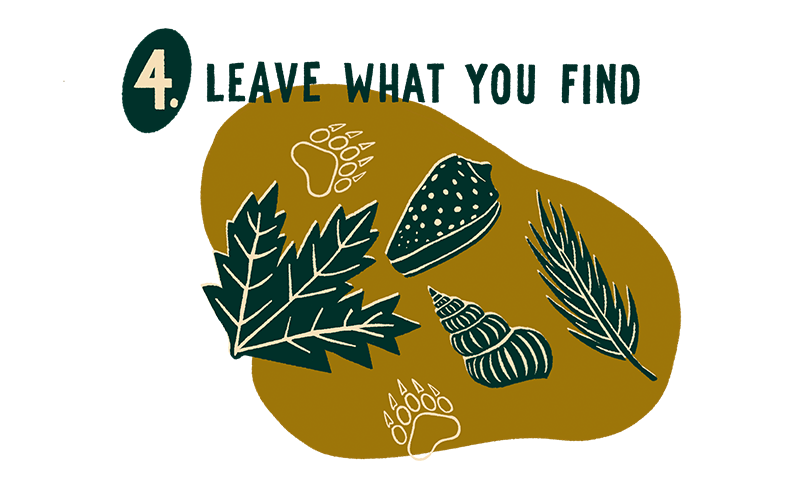
Principle #4: Leave what you find – Mollie’s top 4 tips to think about for your Leave No Trace elopement
The Fourth Principle of Leave No Trace is leave what you find, or as I like to think of it “take nothing but memories (aka photos!) leave nothing but footprints” (on durable surfaces!). Here are four tips to help you understand what “leave what you find” means in the context of elopements:
- Don’t gather things or take anything home with you
- Follow tidepool etiquette
- Hire a photographer (psst.. I think I know your girl!)
- Don’t introduce new plants or animals (this doesn’t include your pet)
Okay, so this principle was kind of a shock to child Mollie, because I loved collecting sea shells from the beach, especially in Virginia and the Bahamas, but “leave what you find” really does apply to everything, especially in National Parks. You’ll want to leave rocks, shells, plants, antlers, fossils, artifacts, feathers where you found them. The “why” behind this principle is similar to the “why” behind Principle #3. First, we want to keep these areas special long-term for all visitors, and if every one of the millions of visitors to our public lands brought home even just one trinket each, we’d quickly see many fewer trinkets out there for us to get excited and awed to stumble upon. Second, these things are part of the local ecology. Birds repurpose feathers in nests. Shells, driftwood or petrified wood can become a small animal’s home. There’s also one other reason to leave what you find that applies a special sub-group of things you might find when you’re on public land– the Archaeological Resources Protection Act and the National Historic Preservation Act are two laws that protect artifacts and anything else that is 50 years or older. This even includes logging equipment and tin cans.
I love exploring the tidepools with my couples especially in places like Ruby Beach on the Olympic Peninsula, but what do tidepools have to do with Leave No Trace and leaving what you find? Although tidepool etiquette could fit into a few of the principles, one important part of tidepool etiquette is what to do if you want to peek under a rock. And the answer is actually pretty much exactly what the fourth principle of Leave No Trace recommends. If you peek under a rock, you want to put it back the exact same way when you’re done. According to the Olympic Coast National Marine Sanctuary, “leaving a rock “belly-up” is an almost sure way to kill any animals that were living on its underside – not to mention those that dwell on its upper side.” If you’ll be visiting the coasts during your elopement, you should definitely familiarize yourself with the all of their tidepool etiquette guidelines.
Clearly, one of the best ways to “take nothing but memories,” is to take tons of photos (and/or video!). Hiring an elopement photographer for your big day means you don’t have to worry about capturing all the incredible moments. Reach out to me to learn more about my elopement photography packages. Extra bonus: I always bring snacks!
Last tip: don’t introduce foreign plants or animals into new environments. Okay, this one sounds a bit strange at first, but once I share the reasoning behind it, it should make more sense. Bringing plants and animals into a new environment could irreversibly harm native species (and especially those most at risk like threatened and endangered species) over time. Sometimes these plants and animals have no natural predators and become what we call “invasive species.” Invasive species have contributed to the decline of 42% of the country’s threatened and endangered species. Remember that plants and animals can be microscopic! So, it’s best to avoid transporting weeds, aquatic plants or even firewood from far away. Pro-tip: check in with your florist to see how they try and prevent tiny pests from hitching a ride on your bouquet.
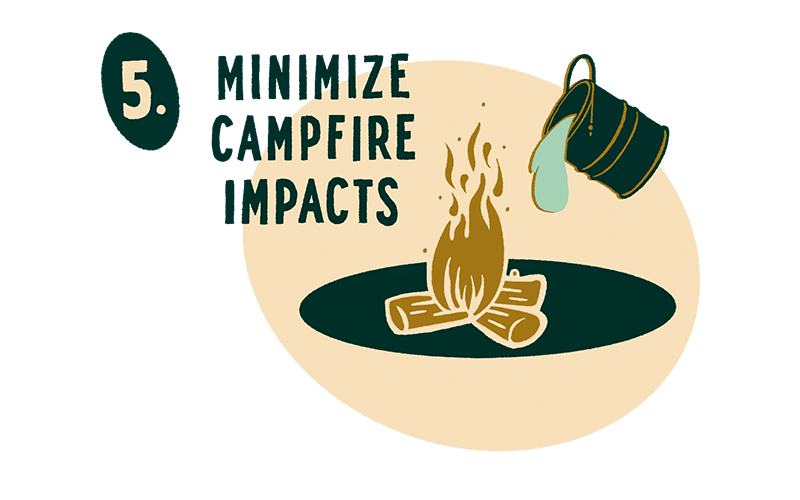
Principle #5: Minimize campfire impacts: three tips for how to include a Leave No Trace campfire in your elopement
The fifth principle of Leave No Trace relates to one of my absolute favorite things — fires! It’s hard to think of a better way to end an elopement day than in front of a campfire or bonfire toasting s’mores and popping champagne or your beverage of choice (yes please!). But improperly maintained fires can also start wildfires. Here are three ways to minimize your campfire impacts on your elopement day:
- Check fire regulations
- Bring a fire pan or propane fire pit or use established fire pits ( & don’t create new rings)
- Follow these 5 Fire Safety & Management Tips
Bonus tip: skip the sparklers and bring LED candles or string lights (they even make solar ones now!)
First, when you’re researching or booking where you’ll stay on your elopement night, make sure you double check the airbnb, hotel, or campground’s fire regulations, and ask yourself some of these questions. Are there any current fire bans? Do they have fire rings or fire pits? (In my experience, most established campgrounds do provide fire rings.) Is it ok to gather wood? (most National Parks do not allow wood-gathering). Does the campground host sell wood at the campground? (they usually do, and you’ll want to bring cash!). If they do sell wood aim to buy local instead, since firewood can be a great way to accidentally transport invasive species. (See Principle #4, above).
If you’re planning to camp in the backcountry after your elopement day, you may want to bring a fire pan or propane fire pit. Otherwise, use established fire rings and avoid creating new ones. Did you know fires can scar rocks or soil, kill vegetation and sterilize soil for up to 6 inches below the ground? Yup. All true.
If you’re planning a bonfire or campfire during your elopement, here are five fire safety and management tips:
Leave No Trace Fire Safety & Management Tips
- Remove trash from the fire pit & don’t burn food, foil-lined packets or other garbage
- Don’t leave the fire unattended
- Burn the wood completely to ash
- When you’re ready to go to sleep for the night, saturate the ash with water, make sure it’s cool to the touch (you should be able to touch it without it feeling hot on your hand)
- Use a metal shovel to mix the coals, water, and dirt in the fire pit as much as necessary to make sure everything is cold and completely extinguished!
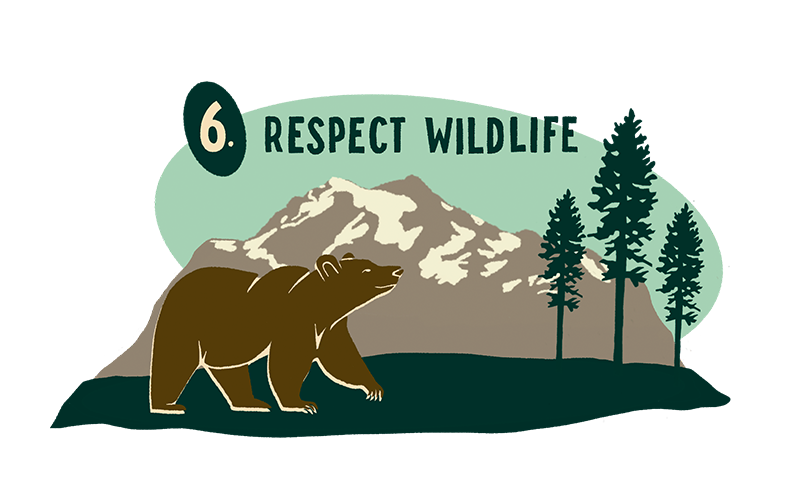
Principle #6: Respect wildlife – how to keep wildlife interactions during your elopement day Leave No Trace
The sixth principle of Leave No Trace is respect wildlife. I love when I get the chance to see wildlife in their natural habitat, especially when I’m out with couples on their big adventure. Respecting wildlife is actually embedded in many of these principles, because leaving their environments as pristine and untouched as possible is the first part of showing these living creatures respect. Here are a few additional things to think about if you’re lucky enough to run into wildlife on your elopement day:
- Don’t feed animals!
- Store your food securely (& use bear lockers at campgrounds when provided or required)
- Observe animals from a distance
- Keep your pups on a leash
We can respect wildlife by not feeding them or purpose or accidentally leaving food behind. This includes all animals, even rodents, chipmunks, marmots, or birds. A big reason to avoid feeding animals our human food, is that over time animals get habituated to humans and start relying on us for food. This can also cause them to completely change their natural diet or even alter their natural behavior (usually this means they’re more likely to be aggressive around humans, and they might even do something like try to grab your food or chew through your backpack to get at your super delicious snack).
Storing your food securely and using bear lockers when they’re provided is another way to respect wildlife. One thing I’ll mention here that isn’t always obvious is that “food” in this case, doesn’t only mean what we think of as food. It actually means anything that is scented or smells (yep! Even your scented toiletries, hand sanitizer, face wipes). Animals don’t know the difference between an edible and non-edible good smell. And animals like bears can become super sick or even die from consuming food wrappers, chemicals (like in our sunscreen, bug spray, or other products) and other inedible things that we may forget to store properly.
Recently, while I was out shooting an elopement with an incredible couple at Olympic National Park, we had a deer friend visit mid-shoot. It’s always an amazing day when we get to witness other living creatures in their natural habitats. If you’re as lucky as we were, the best thing to do is to let the animal be. Observe from a distance. (Even though my photos from this elopement might make it look like I was very close to the deer, I was using a telephoto lens, which makes the wildlife look much closer than it actually is!) Do not follow or approach, and avoid quick movements and eye contact, both of which can be seen as threatening by certain species. Use your common sense here, too. If the animal responds to your presence, back away further and give them more space. Take responsibility for children and furbabies. Teach your kiddos why they shouldn’t approach, pet, feed, or chase wildlife. Larger animals like bears and elk generally need more distance to feel safe, and be especially cautious during the seasonal rut (aka mating season for elk). It was so cool to watch the deer check out the soon-to-be married couple, and I even captured a few photos of the curious deer checking out my couple (I totally get why!) before the deer headed off back into the trees.
Speaking of pups, the best way to follow Leave No Trace when it comes to dogs is is to look up and follow the local regulations, and when in doubt, keep them leashed. That way they won’t be tempted to chase animals and you’ll be able to easily pick up their waste (treat dog waste like other waste! See principle #3, above). That said, if you’re in public lands that allow off-leash dogs, like some national forests or BLM, it’s best to keep them within eyesight or voice control. If you plan to tie your dog up to a tree at any point during your elopement, make sure to use webbing at least 1 inch wide (this is also called a “tree saver”) to prevent girdling (aka damage to the tree bark).
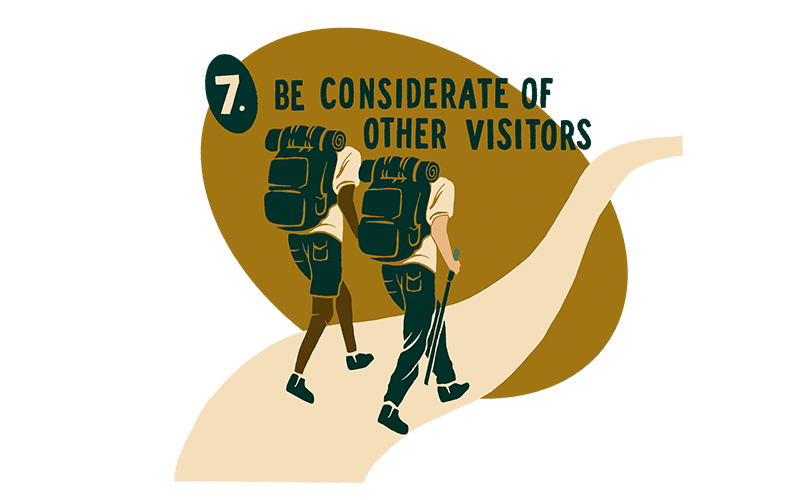
Principle #7: Be considerate of other visitors – 4 tips to respect other visitors during your Leave No Trace elopement
The seventh principle of Leave No Trace is be considerate of other visitors. Honestly, I love running into other hikers on the trail on elopement days because pretty much everyone I run into is as stoked to witness an incredible moment in a stunning place as I am to capture it. (I’m not crying… Ok, yes I am!) But, we’re sharing these incredible spaces with others, and everyone has a different reason for getting outside. So here are my top four tips to help you respect other visitors during your elopement:
- Consider a mid-week elopement and less-crowded trails (or National Forest or State Parks!)
- Follow Leave No Trace hiking etiquette
- Take your rests off the trail
- Minimize sound levels, use of lights and other electronics
I always recommend my couples consider non-weekend days for their elopement. This generally means you’ll run into fewer people, and that popular trailheads will be less crowded. Another great choice that also tends to be less crowded and just as stunning is to elope in a National Forest or State Park instead of a National Park. (Psst.. there are SO many incredible lesser known National Forest elopement spots and pretty much ALL of them are dog-friendly! If you want to learn more, reach out to me! I’d love to help you find the perfect National Forest or State Park location for your elopement day.)
On your elopement day, you’ll want to follow Leave No Trace hiking and passing etiquette: greet others on the trail (a smile and a hello are a great start!) and step aside to let others pass (if you can). Livestock like horses and donkeys always have the right of way on the trail. Move to the downhill side of the trail to let them pass, and keep any chats lower volume, since horses and other pack animals can spook easily from loud noises.
If you need to take a break or rest during your hike, step off the trail (onto durable surfaces like rock or bare ground!).
One other way to respect other visitors is to be mindful of your electronic and sound use. Some people love listening to music when they’re outside, and other people prefer silence so they can tune into the sounds of nature. Since you don’t know what others prefer, it’s better to keep your music, lights, and other electronic use to a minimum (or, if you’re at a campground you can always walk over to your neighbor, say hi, and ask if they mind if you play some music).
Leave No Trace social media, geotagging & shaming
In 2018, Leave No Trace issued new guidance around social media use. Social media has undoubtedly changed our lives, and I think mostly for the better! I love connecting with couples, wedding vendors, and elopement photographers through IG, pinterest, and Facebook. Social media also makes it easier for everyone to find beautiful places that are also closer to home or accessible, which I’m here for!
That said, here are a few things for couples and elopement photographers to think about when it comes to social media and Leave No Trace:
- Think before geotagging
- Be mindful of what your images show
- Like all Leave No Trace Principles, this is nuanced! Don’t shame others!
Think before geotagging. On instagram, the geotag feature uses the exact latitude and longitude stored in your phone. Outdoor advocate and environmentalist, Katie Boue, addressed geotagging on her blog. She suggests that one reason geotagging may be problematic is that it “shortcuts the educational aspect of learning about a place.” She also offers other more serious examples of some ways geotagging has been harmful for the environment: poachers have used geotagging to track rhinos, or orchids (which are also poached in Florida — umm wow!). If you chose to geotag, you may want to include Leave No Trace education that’s relevant to the area. Or you might consider tagging the National Park or state instead of the exact trailhead or GPS location. Either way, when choosing what to post on social media, think about what your photos are showing through the lens of the Leave No Trace Principles. For example: you may not want to post images of you frolicking through a field of wildflowers. (Now that you’ve learned this isn’t exactly a durable surface!).
That said, if your main reason not to geotag is to protect pristine places you grew up with and love from other visitors, check out this article from Melanin Basecamp. It offers five reasons you may want to geotag on social media. One is that protective reasoning like I outlined above is actually a form of gatekeeping. The article also shares additional thoughts for brands, influencers, and outdoor lovers to consider when they go outside. One that I love is to consider National Forest or State Parks instead of the known hot-spots and National Parks (I’m so down to show you my favorite National Forest spots! Bonus: they’re not only usually less crowded, but they’re almost always much more dog-friendly!).
Which is all to say, this topic is super nuanced! If you want to learn more about geotagging and Leave No Trace, I definitely recommend reading the Leave No Trace social media principles, Katie Boue’s take on geotagging, and Melanin Basecamp’s response to the social media guidelines. And no matter what you choose to do when it comes to geotagging, don’t shame others for their choices!
Meet your Leave No Trace elopement photographers:
We feel most at home in the outdoors, so it’s no surprise that is where we gravitate towards as your leave no trace elopement photographers. Between the Pine was founded by Mollie in 2018 and she has hiked hundreds of miles all over the Pacific Northwest and Kauai, to capture couples during their best day ever. Since 2018, we’ve grown our team and continue to hire even more incredible photographers!
Our team at Between the Pine is passionate about our jobs and adventuring to the most beautiful locations to document your best day ever. We know the Pacific Northwest like the back of our hands and are dying for a reason to head back to the mountains, forest, and everything in between! Click here to learn more about the Between the Pine team, your leave no trace elopement photographers!
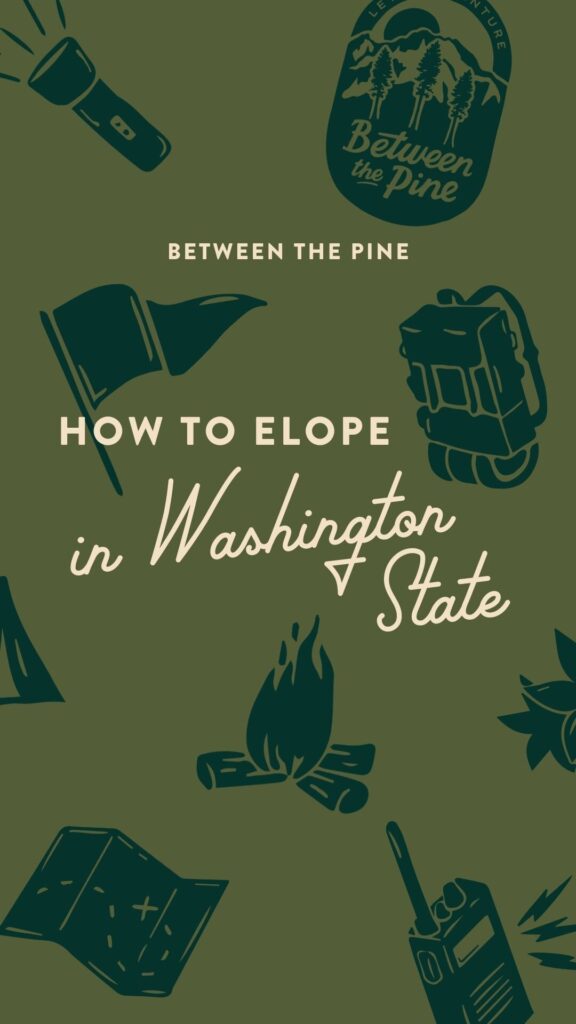
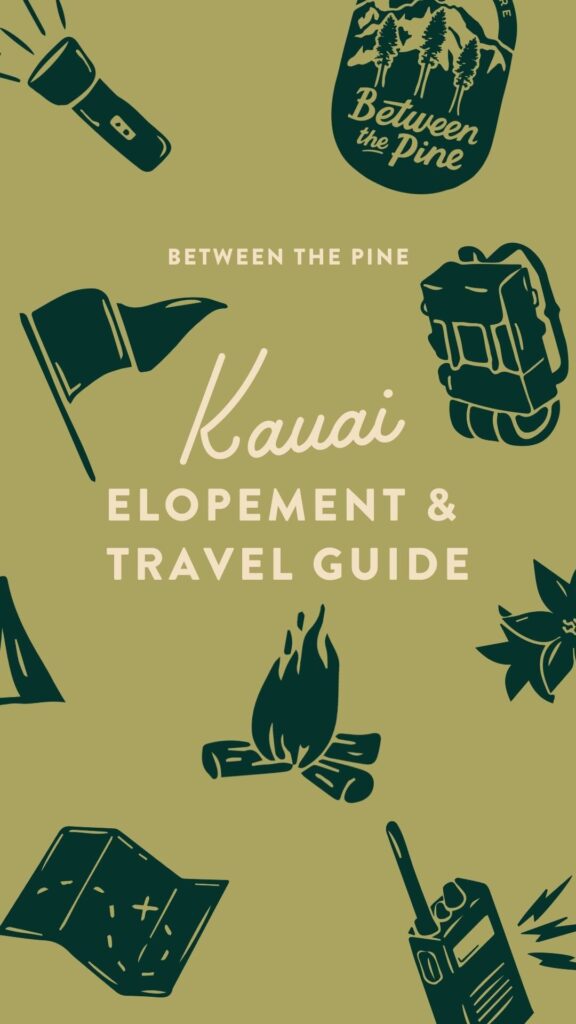
My purpose out here today is to share this article to the world about how Doctor Odunga helped me in getting back my EX-boyfriend that broke up with me 4 months ago. I tried all i can to make him see reasons with me so that we can continue our relationship but he denied me. Thank God for giving me the thought of going into the internet for help, i searched properly and i saw different reviews of Doctor Odunga and i insisted in giving it a try by contacting him via what’s app on (+2348167159012). He gave me reason to live again and he prepared a spell and told me that my Ex-boyfriend will come back to me within 28 hours. Can you believe it, my EX-boyfriend came back to me and our wedding will hold Soon. Contact him now!!! if you need any help. Email: odungaspelltemple@gmail.com and he does a lot of spells. Once again i want to say am very grateful for your help
My purpose out here today is to share this article to the world about how Doctor Odunga helped me in getting back my EX-boyfriend that broke up with me 4 months ago. I tried all i can to make him see reasons with me so that we can continue our relationship but he denied me. Thank God for giving me the thought of going into the internet for help, i searched properly and i saw different reviews of Doctor Odunga and i insisted in giving it a try by contacting him via what’s app on (+2348167159012). He gave me reason to live again and he prepared a spell and told me that my Ex-boyfriend will come back to me within 28 hours. Can you believe it, my EX-boyfriend came back to me and our wedding will hold Soon. Contact him now!!! if you need any help. Email: odungaspelltemple@gmail.com and he does a lot of spells. Once again i want to say am very grateful for your help